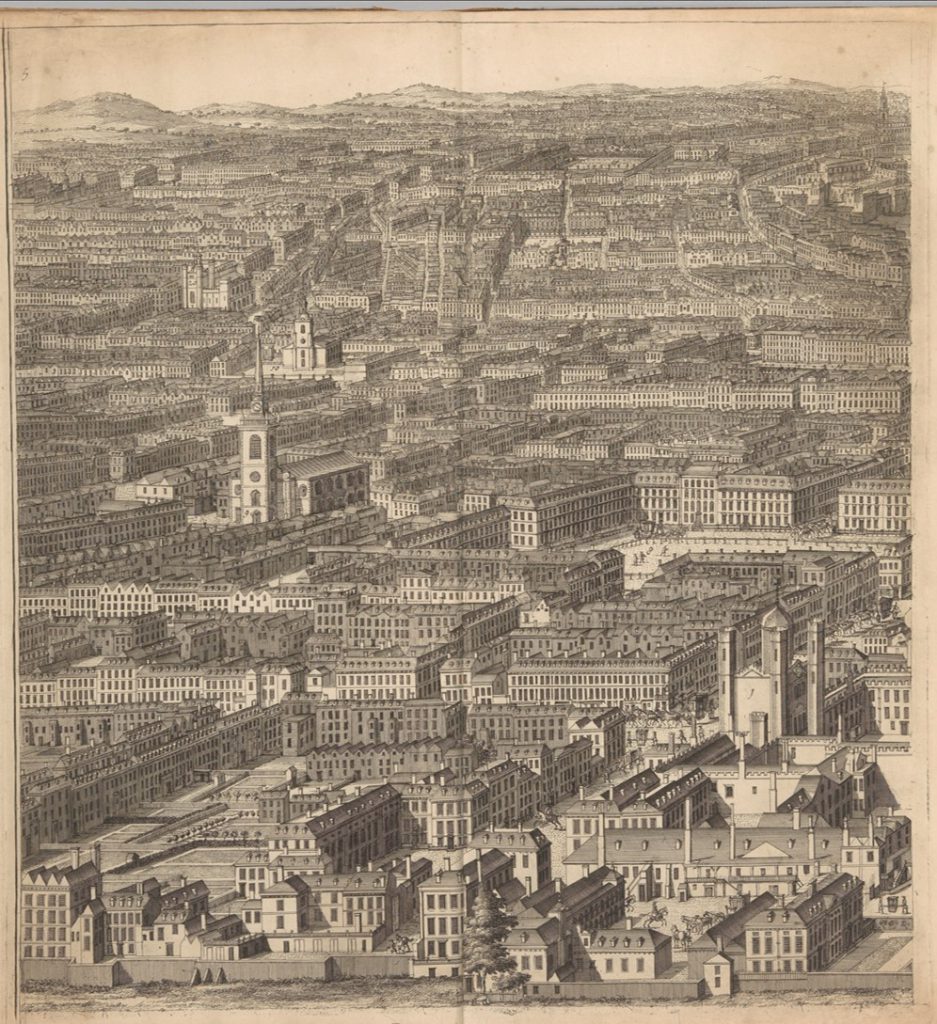Gregorio Astengo, ETH Zurich and Birkbeck; Respondent Elizabeth McKellar, Open University
When: Friday 3 February 2023, 6-7.30pm – A HYBRID EVENT
Where: Room 106, School of Arts, Birkbeck, 43 Gordon Square, London, WC1H 0PD
OR ONLINE
Microsoft Teams meeting
Join on your computer, mobile app or room device
Click here to join the meeting
Meeting ID: 367 736 806 816
Passcode: vtqgmL
Download Teams | Join on the web

John Kip, View of Central London from the West End, 1710 (detail)
The second half of the 17th-century was a period of significant transformation in the building world of London: a combination of political instability, demographic and urban growth, social change and professional reconfiguration, produced profound shifts in the building sector, which started move towards a national industry. The Great Fire of 1666 precipitated this process by quickly opening up a vast market of speculative housing reconstruction and urban expansion. This paradigm came to dominate London’s building landscape for the following centuries, generating new building typologies, like the Georgian terrace house, as well as novel professional figures, like the real estate developer.
Within this context, the project Printing for the ‘City-Builder’ addresses the ways in which knowledge on construction practices came to be codified through a new form of literature, the building guide. This type of book, which became popular from around 1650 onwards, collected and synthesised for the first time basic instructions for potential speculators: techniques for surveying, lists with prizes and sizes of building material, wages for contractors and labourers, charts for interest rates, values for rents and leases, and sometimes ready-made building plans. Unlike the architectural treatise or even the building manual, the London building guide was dedicated to neither design principles nor construction techniques, but rather to the practical processes of what today we may call building management. Many of these books, such as Henry Phillips’ The Purchaser’s Pattern (1653), Stephen Primatt’s The City and Country Purchaser and Builder (1667) and William Leybourn’s A Platform for Purchasers, a Guide to Builders, a Mate for Measurers (1668), were produced by surveyors, printers and sometimes even building peculators themselves, in order to turn building investments into formalised and straightforward financial operations.
As such, the content of the building guide was formulated by the diffusion of speculative housing construction as an informal and still changing set of practices in 17th and early 18th-century London. In turn, the production of these books aimed at theorising such practices and codifying generalisable notions on real estate investments. The building guide therefore represents a key source for understanding and making sense of the processes of production of the built environment from the lesser-known perspective of early modern building developers. This project therefore addresses the building guide an autonomous form of technical literature meant to establish an architectural and cultural theory of real estate.
Gregorio’s talk will be followed by a response from Prof. Elizabeth McKellar.
All welcome. No need to book.
Gregorio Astengo is an architect and historian. He holds an MA from Turin’s Polytechnic (2012) and a PhD from the Bartlett School of Architecture (2019). Gregorio has been teaching at UCL and Queen Mary (University of London), Syracuse University London and the New College of the Humanities and is currently postdoctoral researcher at ETH Zurich. Beginning in January 2023 Gregorio is based at the Birkbeck as a ‘Postdoc Mobility’ Fellow of the Swiss National Science Foundation.
Elizabeth McKellar is Professor Emerita in Architectural History at the Open University and the President of the Society of Architectural Historians of Great Britain. She specializes in British architecture and culture and urbanism, particularly that of London. She is the author of many books and articles including: The Birth of Modern London: the development and design of the city 1660-1720 (MUP, 1999); Articulating British Classicism: New Approaches in Eighteenth-Century Architecture (Ashgate, 2004); Neo-Georgian Architecture 1880-1970: a reappraisal (Historic England, 2016); and Landscapes of London: the City, the Country and the Suburbs 1660-1840 (YUP, 2013). She held a Leverhulme Research Fellowship in 2011-12 to research the latter book which was the winner of the Society of Architectural Historians (US) Elisabeth Blair Macdougall Award 2017. She is currently writing a cultural biography of Sir John Summerson, for which she was awarded a Paul Mellon Senior Fellowship in 2018-19 and a Leverhulme Emeritus Fellowship for 2021-23.



Leave a Reply